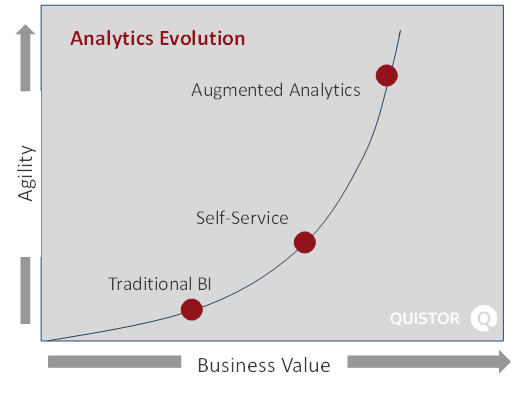Augmented Analytics: Empower Your Data & Your Business
What is Augmented Analytics?
Nowadays businesses are collecting increasing amounts of volumes of data, structured and unstructured alike. IDC predicts that the “global datasphere” will grow from 33 zettabytes (ZB) in 2018 to 175 ZB by 2025.
As you can imagine, companies are really interested in figuring out how to make decisions based on the huge amounts of data provided. Unfortunately, traditional analytics solutions will only take businesses so far when attempting to make use of them. Data continues to grow exponentially, and analytics solutions should therefore be doing the same.
Augmented Analytics is the next step of traditional analytics or business intelligence (BI) tools to treat the amount of data. It is the link between two technologies: analytics and artificial intelligence (AI). Analytics is the process of identifying patterns in data. AI is the computer science practice of building automated systems that can perform tasks that normally require human intelligence. It encompasses a broad range of technologies, such as computer vision, Natural Language Processing (NLP), neural networks, and so on.
When you embed machine learning and AI into analytics, you get Augmented Analytics. It is a technology that automates the selection and preparation of data, the generation of insights, and the communication of those insights.

Oracle Analytics Cloud (OAC) and Augmented analytics
I would like to share with you what Gartner has said about Oracle Analytics Cloud. Oracle is a visionary in its Magic Quadrant, for the first time since re-entering it in 2017. Its continued focus on Augmented Analytics is now coupled with an improved go-to-market approach.
Oracle’s Augmented Analytics’ capabilities are available both in the Oracle Cloud and on-premise. Oracle Analytics Cloud offers an integrated design experience for interactive analysis, reports, and dashboards. It also continued to enhance its innovative Augmented Analytics and NLP integration with OAC and collaboration tools, such as Slack and Microsoft Teams and added an analytics catalogue.
Strengths
- Augmented Analytics and robust NLG (Natural Language Generation): Oracle has implemented Augmented Analytics capabilities across its platform earlier than most other vendors, and reference customers reported broad use of its Augmented Analytics features. OAC also features NLG with adjustable tone and dialect in English and French (eight more languages are on Oracle’s roadmap). It is the only platform on the market to support NLQ (Natural Language Query) in 28 languages.
- Product vision: Oracle continues to invest heavily in Augmented Analytics capabilities and consumer-like, conversational user experiences, including chatbot integration coupled with autogenerated insights. These are central to OAC and Day by Day, Oracle’s mobile app.
- Full-stack enterprise cloud: Oracle offers an end-to-end cloud solution, including infrastructure, data management, analytics, and analytic applications with cloud datacenters in almost all regions of the world. During 2019, Oracle made significant investments in its Oracle Analytics for Applications, which offers native integration, packaged Augmented Analytics, and closed-loop actions for Oracle’s ERP, human capital management, supply chain, customer experience, and NetSuite products.
What Does Quistor think?
Quistor is certain that Augmented Analytics will completely transform the user experience, making the shortage of data scientists less urgent for many businesses. Things are changing and they are changing fast.
Augmented Analytics will help users access any data needed from business, IT, analytics, etc to:
- Recommend which data you should include in analysis
- Alert users when datasets are updated and suggest new datasets if users are not getting the results they expected.
- Respond and consult in the clients native language (NGL).
- Get accurate forecasts and predictions in just one click.
- Through self-learning, it will even anticipate future questions that perhaps a user has not thought of yet.
Augmented Analytics will be the cornerstone of the real democratization of data throughout the business. There are four ways to use analytics: descriptive, diagnostic, predictive, and prescriptive. Prescriptive will be the next step and it is time to start anticipating what we will need to make our business more competitive.
Author: Iñaki Aguirregaviria
Manager Business Analytics & Big Data @Quistor

